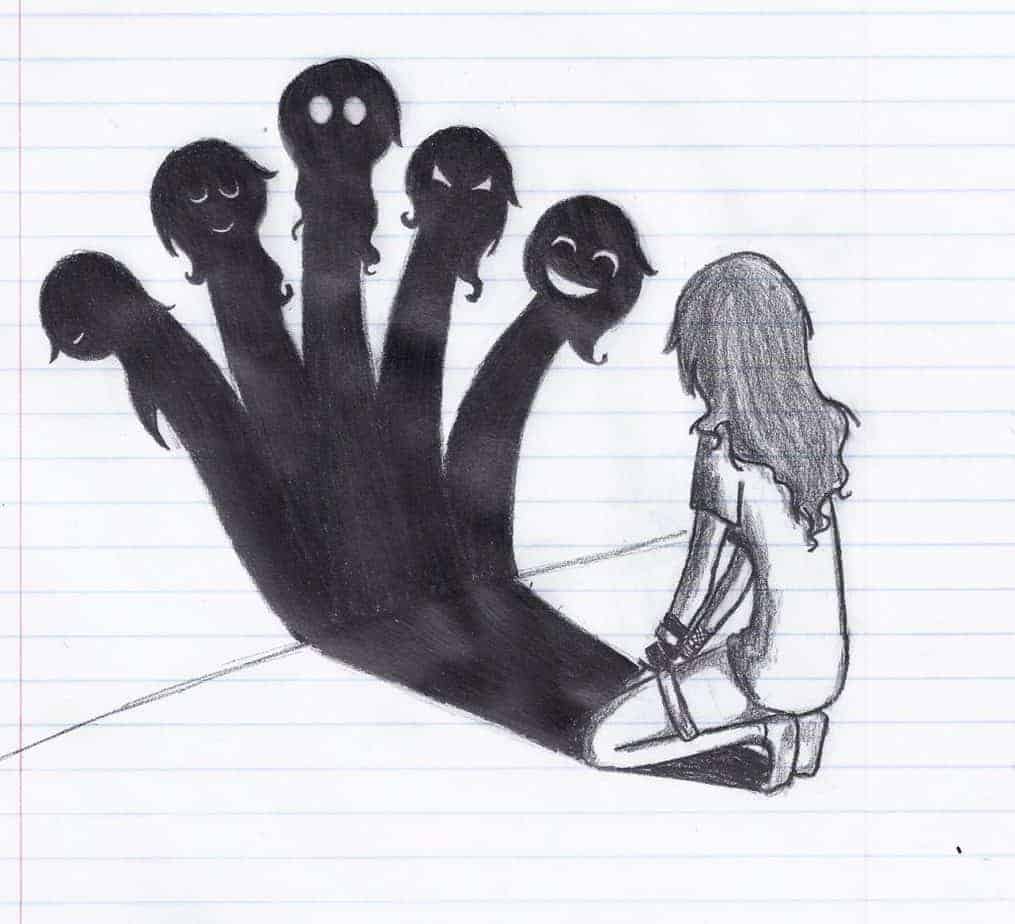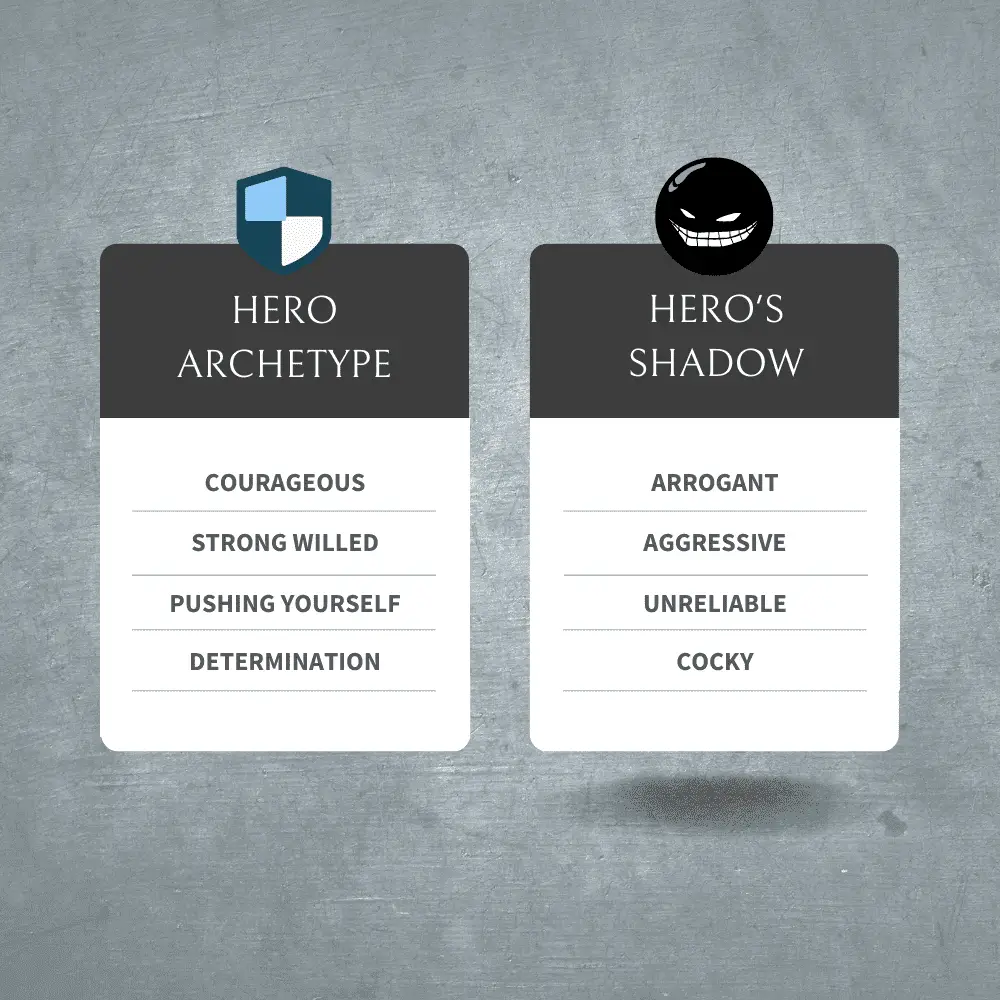Do you ever do something and wonder… why the heck did I do that? Or do you feel like there is some darker side to your personality? It’s something you want to change but don’t know how?
Well, these feelings all come from you trying to reckon with your Shadow.
In this blog post, we will be exploring what the Shadow is and how to use it as a tool for self-growth. Keep reading to learn how to liberate the parts of you that are hidden in the shadows and live a life that feels inviting and abundant.
Shadow Work: What is it?
Shadow work is a technique used to get in touch with the aspects of your personality that you’ve suppressed —or what might feel like your “darker side.” The technique was founded by psychologist Carl Jung to help people integrate the unconscious aspects of their identity.
Shadow Work = bringing the unconscious Shadow to light.
Well… what is the Shadow then?
The basic idea is that there are different parts to our personality. Like how we behave at work, how we act with our family, and so on. There are also parts of ourselves that we have exiled and try not to admit to ourselves — that part is our Shadow Self.
The Shadow can look like:
- Shame
- Fear
- Addictions
- Envy
- Greed
- Compulsion

This quote by Marie Louise Von Franz, a Jungian Depth Psychologist, puts it well:
If you feel an overwhelming rage (or other negative emotions) coming up in you when a friend reproaches you about a fault, you can be fairly sure that at this point, you will find a part of your Shadow. – Marie Louise Von Franz
The Shadow is the behavior you are trying to avert your eyes from.
On the other hand, Shadow Work is a technique to integrate and heal the Shadow. It’s about using self-reflection and self-examination to face these repressed parts of yourself.
We all have a Shadow, and it is a fundamental part of the human experience.
How Does the Shadow Self Form?
You have your normal conscious self, and then there is the Shadow Self. This can beg the question, how does the Shadow Self form?
I really love the metaphor from Robert Bly in his book A Little Book On The Human Shadow. The imagery is that we get a little bag when we are born. As we grow up we put any hurts or parts of ourselves that others call “bad” into the bag. The bag gets bigger and bigger to hold everything we are hiding away.
This bag we drag behind us, out of sight but still connected, is our Shadow Self.

I also like this explanation by the Society of Analytical Psychology.
From infancy and through childhood and adolescence, we pick up from our parents/carers both conscious and unconscious messages about what is acceptable in terms of our body, our feelings, and our behavior. All that is unacceptable is suppressed and repressed and becomes part of our Shadow. – Society of Analytical Psychology
Our shadow traits stem from our need to defend ourselves and survive in whatever circumstance we find ourselves in. However, if we want to live full, happy, and inspirational lives, we must examine our shadows so that we aren’t ruled by them.
In the rest of this article, I will be sharing examples of the Shadow and techniques you can use to integrate these aspects of your personality to be a better parent, lover, and force for good in the world.
10 Real-Life Benefits of Shadow Work
At its core, Shadow Work helps you grow as a person and move past negative patterns holding you back.
Jungian Psychotherapy, which Shadow Work is a big part of, has been found by a study by the University Basel to be 86.6% effective in improving people’s wellbeing. Shadow Work has also been found to help in adult learning environments.
Here is an excerpt from the study by The University of Oklahoma on Shadow Work and education:
Unacknowledged, the Shadow can unsettle the emotional climate of a learning environment and severely inhibit learning. But as the Shadow is brought to light, it can enrich both our professional work and personal development.
Point being… there are a lot of benefits from doing Shadow Work.
Personally, the biggest breakthroughs in my life have been due to Shadow Work. It’s helped me face abandonment issues I experienced as a kid, break me out of codependent tendencies in my relationship, and helped me find deeper inner confidence.
Below is a list of benefits gathered from my own experience, working with hundreds of people through HeroRise, and talking with therapists.
Benefits of Shadow Work:
- A deeper level of self-awareness
- Increased understanding of your talents and weaknesses
- Better at navigating intimate relationships
- Emotional independence
- Healing generational trauma
- Getting in touch with your creative side
- Better communication at work and home
- A healthy and balanced feeling of self
- Acceptance and healing of pain and shame
- Improved self-esteem and acceptance of oneself
Damages from avoiding your Shadow
The flip side of this is what do you have to lose by not doing Shadow Work?
Well… a lot.
I am sure you have experienced yourself hurting someone, yelling out of turn, and/or behaving badly for no apparent reason.
That is your Shadow bubbling up to the surface. If you don’t face this part of yourself, it will be a rouge agent that recks havoc on your life.
I really like this quote from the Society of Analytical Psychology about if you ignore the Shadow:
At worst, the Shadow becomes inextricably entwined with abandonment anxiety so that its emergence can really feel like a matter of life or death. – Society of Analytical Psychology

In other words, it’s better to consciously face your Shadow than it is to let it burst out in unhealthy ways.
Negative effects/impacts of the Shadow:
- Self-sabotage
- Anxiety
- Depression
- Lack of confidence
- Guilt and Shame
- Resentment
- Defensiveness
- Judgment
- Jealousy
- Stonewalling
- Aggression and rage
- Addiction
Getting Started: 7 Best Shadow Work Exercises
Now that we have looked at what Shadow Work is and its benefits, I want to share techniques and exercises to integrate/heal your Shadow.
Over the past 10 years of doing this work, I have found the following 7 different activities to be incredibly potent at healing the Shadow.
Integrating the Shadow comes down to 3 steps.
- Recognizing your Shadow
- Accept Your Shadow
- Rebuild your identity (changing the pattern)
READ MORE about the Stages of Integrating the Shadow
Many of the following Shadow Work Techniques can help you with one or more of these stages. For instance, journaling is helpful in recognizing your Shadow, while therapy is great at accepting and rebuilding your identity.
Working with your Shadow in multiple avenues is the best way to see positive change in your life.
1. Journaling / Writing Prompts
One of the most tried and true methods of Shadow Work is using writing activities.
Journaling is a very powerful therapeutic practice and has been used to help heal emotional trauma. I like the book Writing to Heal by Dr. James Pennebaker, where he explains,” When we translate an experience into language, we essentially make the experience graspable.”
Freewriting is a type of journaling where you sit down and let the pen move on paper as fast as you can. It helps you get out of your mind and get into a flow state where words just pour out of you.

What’s happening is you losing the grip of the conscious mind and letting the subconscious (where the Shadow lives) come forward. Let yourself get into the flow for 20-40 minutes when doing this exercise.
Afterward, look back at what you have written. There are amazing insights to be found.
Journaling can help you recognize your Shadow and discover patterns/behaviors you are suppressing.
Six Writing Prompts you can use to explore your Shadow:
- What attributes in other people drive you crazy? Can you identify where this came from?
- What are some of your toxic behaviors? Where do they come from?
- What is an addiction you have that you don’t tell anyone about?
- Is there something you really want, that you won’t let yourself have? Why not?
- What was an action you regret doing in the last 2 weeks? Why do you think you did that?
- What characteristics are you afraid people will think you have? Why?
- Are you holding on to any past trauma? How is it affecting your reactions to others?
These writing prompts are designed to help point out parts of your identity that you try to avoid. Shadow Work can be really uncomfortable because it brings up a lot of hurt feelings, but accepting these parts of yourself is the path towards healing.
I also shared an article, check it out, with a three-part writing activity to help integrate your Shadow.
2. Watching Emotional Triggers and Reactions
One of the fastest ways of discovering your Shadow is following your emotional reaction and noticing your triggers.
So what is a trigger?
A trigger is an emotional response to a situation that reminds you of past trauma. It can cause you to act out or react, as if by reflex.
It’s like putting your hand on a hot stove and learning not to do that again.
Triggers are developed out of a need for self-preservation, but they can cause you to overreact or spiral you out.
These triggers can be valuable information you can use to illuminate your Shadow.
A good example was when I was younger, I was constantly moving. I learned to not let people in all the way because it was too painful to leave people behind all the time. This pattern kept coming up in my intimate relationships, and I would be with my partner in a beautifully close moment and then find myself jerking back.
Once I saw that I was triggered by closeness, I explored what part of my Shadow was wrapped up in my intimate connections. I realized that I was afraid of being abandoned and thought I was unworthy of the connection. Seeing this opened up the path for deep healing.
Here are steps you can take to integrate your Shadow through watching your emotional triggers:
- Try to pay attention to your reactions, if you have any reactions that are unexpected or out of the ordinary, take note of them.
- You can write the situation down or make a voice note on your phone.
- When you have time, take a moment to reflect on the situation.
- Ask yourself what specific person, situation, or action you were reacting to.
- Ask yourself what did it remind you of? Where did the feelings come from?
I have done this activity in my men’s groups and with individuals. I have seen firsthand how powerful it can be to bring awareness to emotional reactions and how it can lead to such great healing of the Shadow.
3. Working with a Therapist
When doing Shadow Work, it can be incredibly helpful to work with a Therapist. They can be an alley that is looking out for you. The work can be hard, and you don’t have to do it alone.
Here are a few reasons to work with a Therapist when doing Shadow Work:
- Explore thoughts, feelings, and worries without judgment.
- Guidance with coping strategies and tools to calm down the nervous system
- They can help with physical and neurological symptoms
- You know you are not alone
- They can help protect you from common mistakes and keep you grounded

Shadow Work can be overwhelming, and having an alley can be incredibly empowering. It is nice to know you have someone you can talk with and process the deep traumas that can come up.
If you struggle with anxiety, sleep, or suicidal thoughts, you will greatly benefit from talking to a therapist. They are so incredibly helpful, and there for you.
There are different therapeutic modalities and things to consider when looking for a Shadow Work Therapist. If you are interested in learning more, check out this article I wrote on working with a Therapist for Shadow Work.
Meditation can be another therapeutic tool for Shadow Work and help you access deeper parts of your subconscious (where the Shadow resides). It can be a useful tool for reflection and healing.
Meditation has also been found to significantly help with anxiety, depression, and concentration.
4. Shadow Work Meditations
Shadow work can be emotionally taxing and having meditation to calm the nervous system can be an important tool.
Regular meditation practice can also help the other Shadow Work exercises, such as helping you become more aware of your emotional reactions.
Another helpful technique is guided meditations.
Guided meditation is when you relax into meditation, usually with eyes closed, and go on a journey within your mind. It can help you get into a dream-like state and is a powerful way to connect to the subconscious.
I have created a guided meditation for exploring the Shadow. You can play it below.
SHADOW MEDITATION:
I wrote an entire article on Guided Meditations for Shadow work and the best Shadow Work meditations.
5. Self Reflection with Tarot
Shadow Work is about bringing the subconscious, repressed, and neglected aspects of your personality to light. Deep introspection is a powerful way to discover and process the Shadow.
Tarot, along with Oracle Cards, has been found by the University of Victoria to be a useful tool for self-reflection. Case studies have found it to be an effective therapeutic tool.
Tarot cards use a collection of specific symbolic images to help communicate with the subconscious. They speak to the deepest aspects of the psyche.

I really liked the explanation by Jungian Therapist Chalice Mathioudakis.
The therapist guides the client through shuffling, layout, and interpretation of the cards, then explores what comes available into consciousnesses. The therapeutic value is not the interpretation itself, rather, it is what the interpretation triggers in the client’s subconscious mind.
Tarot cards and layout position can provide a sufficient context to uncover subconscious material that may otherwise not have been addressed in a single therapy session.
In other words, Tarot and Oracle cards can be used as external symbols for your subconscious to assign meaning to. And in the act of adding meaning to the cards, you are actually uncovering deeper patterns within the Shadow.
I like to use Tarot/ Oracle cards in three ways:
- Use a Shadow Work Tarot spread
- Pick a card for your Shadow and journal about it
- Pick a card to represent your Shadow and meditate on it
I use Tarot and Oracle Cards in my practice a lot. I created the HeroRise Masculine Archetype Deck because of how powerful I found the technique.
Check out my article on using Tarot for Shadow Work for exactly how you can use the cards in your own practice. I also share spreads, decks, and other techniques for using the cards.
6. Exploring Shadow Archetypes
Carl Jung, the psychologist that invented Shadow Work, also developed the idea of Archetypes.
Archetypes are universal symbols that speak to the deep subconscious, and they are patterns that can be seen throughout cultures and time. Such as the masculine archetypes of King, Warrior, Magician, and Lover.
I like to think of Archetypes as focus lenses that can help zoom into one aspect of the identity. A good example would be the Lover. Focusing on the Lover Archetype will help you explore desire, passion, and intimacy in your life.
Carl Jung worked with 12 different Archetypes:

With Shadow Work, it can be helpful to focus on one of these Archetypes and try to explore its Shadow Aspects.
For instance, the Hero Archetype can help you examine your courage. Are you rising to the occasion? What battles can you run towards to save the day? There is a lot of passion and power found in the Hero Archetype.
But… the Hero still has a shadow side.
The Hero can also be arrogant, not a team player, and wreak havoc through ignorance.

For Shadow Work, it can be helpful to spend time with each Archetype and look to see how its shadow aspects show up in your life.
When creating the HeroRise Masculine Archetype Deck, I created two shadows for each Archetype. It was based on the inspiring work of King Warrior Magician Lover.
The HeroRise system has five Masculine Archetypes —Warrior, Magician, Father, Lover, and Sovereign.
Each archetype then has two Shadow Aspects, an overactive and underactive expression of the Archetypes.

Having a clear system like this has made it really easy for me to explore my Shadows. The framework makes it succinct enough yet still open enough for me to explore the complexities of my psyche.
>>> Checkout the Masculine Archetype Deck
7. Share your Shadows with Others
You won’t be able to get that far in integrating your Shadow if you are always keeping it a secret. An important piece to Shadow Work is being open about your process.
It can be incredibly healing to tell a loved one about your fears, shame, and Shadows. Try to find friends that can hold a space for you, and accept you as you are. If they can do that, you will find such deep healing.
What I have found really helpful is to start conversations with my friends about my Shadow. I have used the Shadow Work writing prompts as conversation starters, and it has opened up such rich discussions and allowed me to share deeper parts of myself.
It’s important to know you are not alone in this work.
We ALL have shadows.
Being open with your own Shadow will actually help people trust you more, and it creates profound intimacy with your loved ones.
Shadow Work: How Much Time Does It Take?
After reading about all the different Shadow Work Exercises, you might be wondering how much time you would need to dedicate to Shadow Work.
The first thing you might want to ask yourself is what is your goal.
If your goal is to get rid of your Shadow, then… it will never happen.
You can’t “get rid” of the Shadow any more than you could get rid of your physical Shadow on a sunny day. The Shadow is a natural part of the psyche.
When you bring one aspect of your psyche out of the unconscious mind (the Shadow) and into the conscious mind, something else will occur in the Shadow.
That’s not bad, it’s just how our identity forms and changes over time.
I have worked with many people who have asked the question of “how long does Shadow Work take” and I have discovered there is a little subtext underneath it.
Most people are actually asking how long it will take to move past some trauma or negative behavior they are working on.
Shadow Work is a valuable tool in healing the psyche, but no path is the same for everyone. It will depend on how deep the wound goes, what support you have, and how much time you have to dedicate to it.
The key isn’t to fixate on the final outcome but on the incremental growth.
Does doing shadow work help you grow, by let’s say 5% towards your goal. That might seem small, but that grows exponentially over time. That 5% turns to %10, and 15%, and so on.
Before you know it you can look back and see that you climbed a mountain you once saw was impossible.
Here are a few tips I have for you if you are just starting Shadow Work:
- Consistency is important, so try and separate at least 1-2 hours a week
- If you are working on a core wound, think in terms of years, not months
- Take your time and have patients. There is no way to rush to healing
- If you keep at it, eventually, you will see immense personal growth
- Try tracking your progress through journaling and review past journals every few months/years
In Conclusion: Shadow Work is Worth it!
Shadow Work can be incredibly powerful. It can help you break free of old behavior patterns and find freedom in your relationships.
But… Shadow work isn’t easy.
Shadow Work takes dedication and willpower to look at the harder aspects of your personality, and it also takes time and effort to peel back the layers you have built around your Shadow. That being said, you can still make progress through consistency and bravery.
One of the biggest shadows I had to overcome was this feeling that I wasn’t good enough. I was afraid of getting in trouble or scolded for being a bad person.
For a long time, these feelings were just subtly under my awareness, and they would make me over-commit myself and sometimes lead to depression.
It took me years to realize where these feelings were coming from.
It was the trauma I had around my parents. I was yelled at and shamed a few times as a kid, and I still held on to those feelings.
Because of that, my Shadow always thought I was no good. It would jump out and cause issues in my life.
It took me a good 5+ years to break these patterns. Sometimes the feelings come up, but now I can sit with them and accept that part of my Shadow. It’s a weight I no longer have to shoulder.
Facing the past trauma was not easy, and it asked me to really look at my self-worth. Though the process took a long time, it was critical for me to find happiness in my lifetime.
I share this story in hopes of inspiring you and helping you feel as if you are not alone.
I have seen hundreds of people go through this work. I know it’s hard, and I know without a doubt that it is worth it.
The techniques in this article should help you on this journey.
Stick with it. Great things will happen!
If you are interested in learning more about integrating the Shadow, check out the following resources:
- Five great Books on Shadow Work
- Shadow Work and Healing the Inner Child
- Tarot and Shadow Work
- Understanding the Masculine Shadow
I also created the Masculine Archetype Deck to help anyone explore the Masculine Shadow. The deck gives you a tangible way to explore your psyche. Check it out below.





